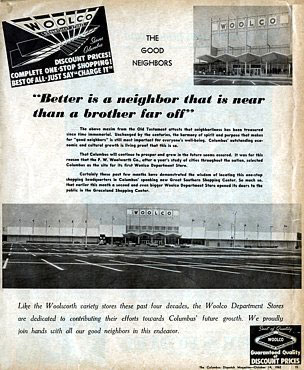The first steps out of town
as Woolworth attempts to diversify
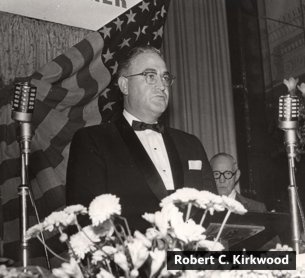 In the mid 1950s the Non-Executive Directors of the giant American Woolworth Corporation lost patience with their executive management. Taking an external perspective they argued that Woolworth had not kept up. It had become too conservative and highly risk averse, preferring the safety of the policies and ideas of yesteryear to the potential of moving ahead and beating the competition. In their judgement this had allowed S. S. Kresge to take the initiative; by modernising it sales had rocketed ahead of Woolworth's for the first time. Profits growth and shareholder returns had continued only because the British non-consolidated subsidary had enjoyed a purple period through the Fifties and had generated ever increasing dividends on the 52% American share. The independent Directors called for radical action, recommending increased borrowing to invest in reshaping and updating the brand.
In the mid 1950s the Non-Executive Directors of the giant American Woolworth Corporation lost patience with their executive management. Taking an external perspective they argued that Woolworth had not kept up. It had become too conservative and highly risk averse, preferring the safety of the policies and ideas of yesteryear to the potential of moving ahead and beating the competition. In their judgement this had allowed S. S. Kresge to take the initiative; by modernising it sales had rocketed ahead of Woolworth's for the first time. Profits growth and shareholder returns had continued only because the British non-consolidated subsidary had enjoyed a purple period through the Fifties and had generated ever increasing dividends on the 52% American share. The independent Directors called for radical action, recommending increased borrowing to invest in reshaping and updating the brand.
To effect the strategy they hand-picked an experienced Company Man who had demonstrated the courage, intellect and vision to stand out from the crowd. Robert C. Kirkwood was appointed President, and soon proved to be an inspirational leader and a formidable businessman. He developed a multi-pronged strategy:
- moving into clothing ("apparel"), soft furnishings ("drapery") and electricals
- relocating Main Street branches into Malls (Shopping Centers)
- converting all the remaining North American stores to self-service
- developing an out-of-town format to rival Kresge's new K-mart
- investing over $1bn to reshape the chain in the USA and Canada
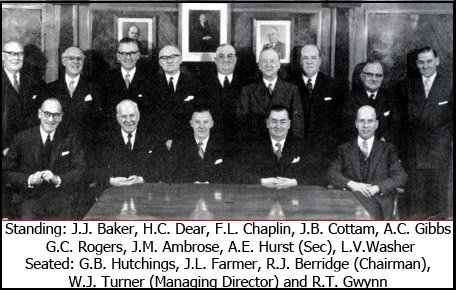
British Board members had reservations about a number of Kirkwood's strategies. There was no trend out-of-town in the UK and they had strong confidence in the High Street. British shopping precincts were unproven, and self-service was proving unpopular with customers and appeared to increase shrinkage as more goods were stolen. Instead they preferred to concentrate on enlarging and improving their existing stores, while keeping a watching brief on the situation in America.

As one stages of effecting the strategy, in 1961 a team of architects and planners worked on a brand new format. It drew some of its ideas from Kresge's new K-mart stores to create a huge out-of-town Woolworth's with new fashions and home furnishings as well as a garden centre and motor section. It sought to provide a non-food one-stop shop. Like K-mart the huge stores were to be sited out-of-town with ample free car parking.
The chosen name, Woolco, had been used by the firm before. It had been the brand name that Frank Woolworth had chosen for his own-label cottons and sewing notions during the Great War of 1914-18, and had also been used in Germany as a label for 78rpm records before World War II. New Buyers were appointed to concentrated on building a Woolco range. They operated as a Company within a Company, with a territory spanning both the USA and Canada.
The first US store opened at the Great Southern Shoping Center in Columbus, Ohio in Summer 1962. In October two further stores opened. One was in Sudbury, Ontario, Canada and the other in the Graceland Shopping Center in Columbus. Over the next three months outlets were added in Richmond, Virginia, USA, and Windsor, Hamilton and Brantford in Ontario, making a total of seven stores. Sales built gradually and customer feedback was positive. But the figures showed that turning a profit would be a long haul. By the end of the decade there were more than 150 Woolco stores in North America.
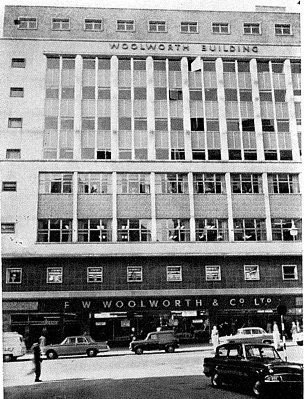
In Britain and Ireland the focus was on the High Street, with the Board developing innovative schemes in partnership with City Councils and development companies to transform some of the inner-city stores - getting brand new, modern Woolworth stores that made better use of space, and selling any surplus land that was released for cash. One example of this was a scheme in New Street, Birmingham, where an old-style store was replaced by a skyscraper which was named 'The Woolworth Building' and incorporated a tower of offices above the shop. The firm retained some of the office accommodation which they sublet as a commercial landlord, while selling the remainder to the developer and adding the funds to the Company reserve.
In other towns like Fareham, Hampshire, large superstores were built a few doors away from existing branches. When building work was complete the Woolworth store transferred business to the bright new premises.

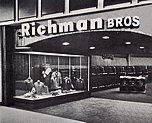
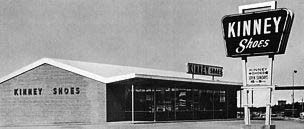
To support Woolco's move into fashion, there were new stateside acquisitions. In 1963 G. R. Kinney Co, joined Woolworth as Kinney Shoe Corporation. In 1969 the suitmaker Richman Brothers was added.
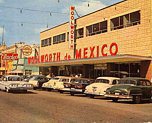
While executives started to reshape Kinney, the Woolworth focus was firmly on Woolco and overseas expansion. They drew comfort from British success in the West Indies and their German wonder-child, ignoring the loss of the existing venture in Cuba as a result of the Missile Crisis.
Five volunteers were hired to pioneer a company in Mexico, in a move reminscent of the British openings fifty years earlier. The chain quickly lifted off, proudly boasting that 97% of goods were locally sourced and every new recruit was hired and trained locally.
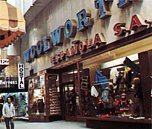
Openings in Spain were less successful. Somehow there seemed to be a cultural barrier which the Company struggled to overcome, despite persisting for more than a decade.
Meanwhile in America the traditional Main Street stores began to look tired, as the pattern of trade continued to move out of town. Some City Centre locations were redeveloped into new Malls, while downtown locations fell into decline.

The parent company continued to put pressure on the British subsidiary to open at least one Woolco store. In 1966 the Board relented and took options on three sites - Oadby (Leicester), Thornaby (Stockton on Tees, Cleveland) and Bournemouth (Hampshire). They planned to stagger the openings, one each year from 1967-1969.
The locations were well-chosen. American scouts assisted in finding them and making the necessary arrangements. They advised the British Architects and Planning Department on all of the details and helped them to evangelise the concept to local authorities. It is hard to imagine now, but at the time there was no out of town shopping, and Councillors struggled to understand why anyone would ever travel to a factory estate for groceries and clothes. Leicestershire County Council, at the heart of England, had a reputation for embracing new ideas and working to regenerate the area. After discussion they approved plans for a Woolco on a huge site at Oadby, a short distance from the City Centre. They also signed off a smaller out-of-town Tesco Superstore with an integral multi-story car park. Both were UK firsts.
It is a testament to the research underpinning the chose of locations that each early British Woolco generated respectable early profits. What is more, despite radical changes in British shopping over the last forty years (including the loss of all of the remaining Woolworth High Street stores in 2009) all three original Woolco locations remain in use with stores with a broadly similar range (give or take the tyre bay and motor servicing!) Today each trades today as an Asda supermarket after a period as part of Gateway (Somerfield).

With 63,000 square feet of selling space, all on a single floor, the air conditioned store at Oadby aimed to offer a one-stop shop for the whole family. It sold fashion and household, jewellery and toiletries and a very large range of groceries. It even had a butchery. Local people wondered why it had so many parking spaces. Eight hundred were provided on the recommendation of experts from the USA, where a higher proportion of households owned a car. A big advertising campaign attracted customers from far and wide. The tactic of describing the stores as an "American shopping experience" paid off. The store employed around 300 people.





The hairstyles and uniforms have dated, but actually many of the features pictured still appear reasonably up-to-date over half a century after the store first opened. Bold displays, sharp signage, clear pricing and many of the lines carried in a department store sat comfortably alongside a large supermarket. At the time the formula was revolutionary. The results far exceeded expectations.
But there were barriers too. Planning consent proved much more difficult to obtain in other counties. A number of brownfield sites were acquired as part of other development schemes that were rejected, sight-unseen by local councils who saw no reason to allow shopping away from the High Street. Woolworth planners did not want to 'rock the boat' by appealing; instead they resigned themselves to taking losses on the disposal of the land.
Twenty years later Supermarkets and out-of-town operators systematically appealed to the Secretary of State and frequently had the local decision overturned. Woolworth took much of the pain to establish the principle of out-of-town shopping, but did not receive any of the gain. Instead most Woolco stores were pitched in unproven development areas around the country, as the firm accepted any location that was offered to maintain the momentum of openings. Trading results in Killingworth Newcastle-upon-Tyne, Kirby Merseyside and Wythenshawe Manchester 23 proved a far cry from the success at Oadby.
There were also obstacles to Woolco inside the business. The Buyers for the main chain of High Street stores were jealous of the autonomy and large budgets assigned to the Woolco team. They engaged in spoiling tactics to undermine the new venture.
By the end of the decade there were three successful British Woolcos with plans for a dozen more. In North America there were already a hundred stores, with fifty further cities earmarked for multiple stores in the Seventies. In Britain plans were in-hand to open in the Middleton Arndale, which would be an 'in-town out-of-town store', and in Killingworth, a new town which had yet to be built. The strategy for 1970s was to give lion's share of investment to Woolco, but its formula still remained unproven.

For more information, our new Woolco Picture Gallery, which uses pictures very generously donated by retired Senior Executive and former Woolco Manager John Dodds, gives a close-up view of the second British Woolco, store 2002 in Thornaby at its opening in 1968.
